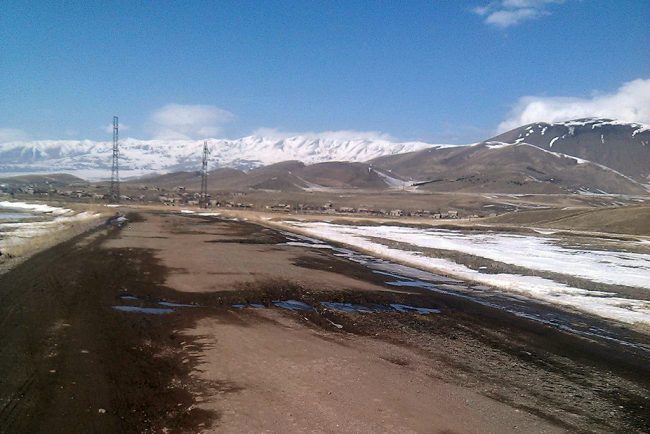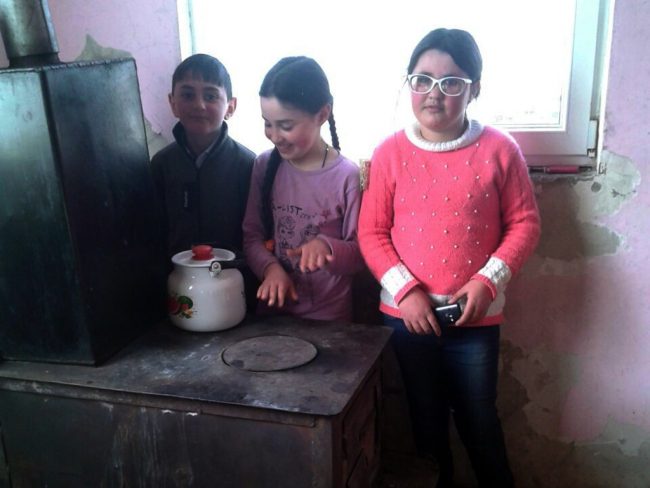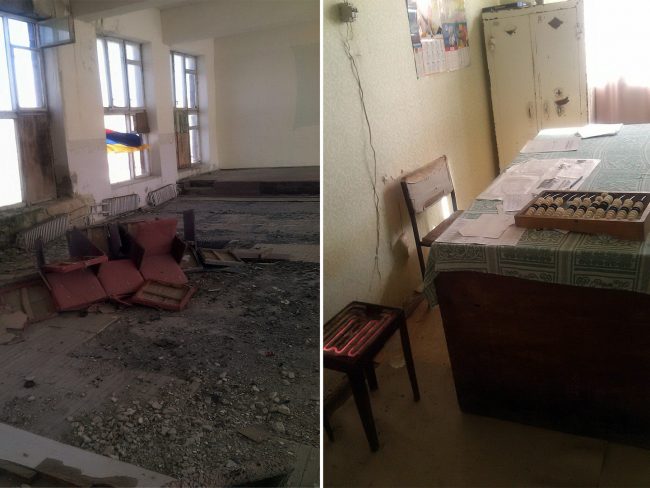


In many remote areas of Armenia, energy poverty remains a serious concern. With no connection to the gas grid, villagers resort to burning illegally cut wood or cow dung to keep warm during winter. But in the border village of Kut, high in the mountains of eastern Armenia, a new hope is emerging in the form of renewable energy.
Every morning Gayane stokes up glowing embers to heat the house before the family gets up. First, she cleans the stove in the dining room, to remove yesterday’s ashes. She puts paraffin on top of a pile of manure in the stove and lights the fire. Because there is no gas in the kitchen, meals are cooked on this stove.
Gayane Verdyan, 38, lives with her husband, Hrachik Chitchyan, and two children in the border village of Kut, located southeast of Lake Sevan in the Gegharkunik Province. The village, as well as the entire province, differs from other regions of Armenia: it has a large refugee population populating its mountainous landscape.
Hrachik’s family is no exception. They came to Kut in the early 1990s from Khanlar, Azerbaijan. In 1996, Hrachik married Gayane, who came from Hrazdan on the other side of Lake Sevan.
Gayane says Kut is a small village, with limited or even no jobs or education opportunities available. They generate income mainly from cattle farming and potato cultivation, both consuming and selling the produce. The villagers also sell cow’s milk for ֏150 ($0.30) per litre. The couple claim they have adapted to the food, jobs, and energy shortages.

Gayane notes that for more than two decades their biggest problem has been the lack of a sustainable energy source.
A village of 185
Sima Chitchyan, a relative of Hrachik’s, worked at the Kut Community Administration for more than 25 years before being appointed Kut Community Head. She says locals have tried to raise the energy issue at different levels of government, but have always been told it’s a non-starter.
‘Energy poverty is not our only challenge; the community doesn’t have a kindergarten, or school infrastructure, or an irrigation system. Due to the dilapidated condition of the administration building, employees can’t stay here long, especially in winter. The windows are broken, the roof is leaking. The building is literally falling apart’, Chitchyan tells OC Media.

‘Kut is a hard-to-reach area’ Chitchyan says, mentioning the condition of inter-village roads, which are almost impassable in winter due to heavy snow. During rainy seasons, the dirt roads are impossible to drive or walk through, she says, which is why many villagers drive old Soviet UAZ-469 military jeeps.
A lack of educational or extra-curricular opportunities for young people makes things worse, contributing to massive emigration rates. Gayane’s daughter, Laura, is enrolled at the Yerevan Financial Academy. She is not sure whether her daughter will return home after graduation.
Chitchyan says that four families left Kut just last year. Many go to large cities — the provincial capital, Vardenis, Yerevan, and even Moscow. The population here currently stands at just 185.
Hope in renewable energy
Armenia’s energy market is highly dependent on fossil fuels for residential heating and cooking — natural gas accounts for 63% of Armenia’s primary energy. Eighty percent of Armenia’s gas imports come from Russia, with the remainder coming from Iran, which is imported in exchange for electricity.
Around 150,000 people in 329 communities have no natural gas connection at all, according to data from Armenia’s Energy Ministry. This is about five percent of the population.
But according to official figures, the renewable energy sector is steadily growing in Armenia. In comparison to wind and biomass pellets, solar energy seems to be the most promising option given that Armenia is sunnier than most of Europe — it receives 1,720 kilowatt hours per square metre of sunlight every year, compared to an average of 1,000 in Europe.
In a recent interview with AFP, Armenia’s former Deputy Energy Minister Hayk Harutyunyan drew attention to the growing renewable energy sector stating that Armenia would at some point have to stop relying on its ageing nuclear power plant, and the country must be ready for this.
‘That’s why, over the past few years, Armenia has been stepping up efforts to develop all types of renewable energy — hydro, wind, and solar’, Harutyunyan said.
The ministry is currently launching a project to construct the country’s first large photovoltaic solar plant in Mets Masrik, a town just 10 kilometres from Kut. Gegharkunik Province could also see the arrival of wind power; Spanish firm Acciona began to assess the wind potential in the area in December 2017, installing a number of 2.8-metre-high wind monitoring stations.
Norayr Benohanian, Energy Efficiency & Renewable Energy Projects Coordinator at Yerevan-based think tank the Acopian Centre for the Environment, is optimistic about renewable energy in Armenia. He says the country is not only diversifying its energy sources, but also implementing energy efficiency projects.
He points to a project the centre carried out in 2016 in Kalavan, also in the Gegharkunik Province, as a good example of how to minimise fuel consumption while keeping houses and public buildings warm during the winter.
The centre organised workshops on energy efficiency after which participants joined villagers in Kalavan to insulate the walls and roof of the village schoolhouse. Since then, the school has been warmer and fuel consumption has decreased.
‘Besides solar and wind power, which could be applicable in these areas, I would also recommend focusing on energy efficiency projects. In this regard, the Kalavan programme could be a good example for non-gasified communities. The villagers can insulate homes and minimise their firewood consumption, which will also minimise stress on the forests’, Benohanian tells OC Media, referring to widespread illegal logging that people often resort to in order to obtain firewood.
But for now, projects such as this are unsystematic and more of an exception, and the involvement of the government remains limited. Benohanian points to a 2013 project under the UNDP GEF programme in which three large residential buildings in Yerevan had thermal insulation installed, with financing provided by the Yerevan Municipality, as a good example of government involvement. A kindergarten in Yerevan was also recently insulated by Yerevan Municipality as part of a UNDP project.
Cow dung comes cheaper — but at a price
Gayane says that cow dung is easy to burn when it’s dried properly. Almost every villager has piles of cow manure either in the pastures or in the barns.
‘We collect the manure, shape it into patties, and then leave it to dry for months. Firewood is unaffordable. This year, it cost ֏25,000 ($50) per cubic metre. So, cow dung comes cheaper’, says Gayane. The downside is the fumes that spread through the house when the chimneys are not installed properly, she says.

Despite its affordability, Diana Harutyunyan, UNDP Armenia’s Climate Change Projects Coordinator, warns of the dangers of heating houses with such stoves.
‘The fumes from burning firewood and dung are detrimental to people’s health, and can lead to diseases such as persistent coughing and chronic bronchitis’, she told OC Media.
‘But it doesn’t release as much carbon dioxide emissions into the atmosphere as fossil fuels like natural gas or coal do, which are harmful to the environment. Therefore, it doesn’t increase CO₂ emissions’, remarks Harutyunyan, noting that the villagers should be attentive to ventilate their houses properly.
A future in pellet fuel
Gayane says they have embarked on new renewable energy projects and are hopeful that things are improving. She is a member of a small agricultural co-op which was established within a project launched by Researchers for the Bio Heating Solutions NGO in 2013. The researchers built a passive solar greenhouse in Kut, the ultimate goal of which was to demonstrate biomass pellets — made of renewable substances like recycled wood waste, straw, and agricultural residues and used in residential buildings in specifically designed stoves — and energy efficiency within the agricultural sector, particularly in agricultural greenhouses. The passive solar greenhouse model was later replicated in Horbategh, in the neighbouring Vayots Dzor Province to the south.
The difference between a traditional greenhouse and a passive solar greenhouse is that traditional ones do not have walls. The greenhouse is specifically designed to be viable in high altitude areas, like Kut.
The Kut greenhouse has a large wall on the northern side, and smaller ones on the eastern and western sides. It often does not require heating at night or in winter.
The greenhouse is now operated by co-op members comprised of four families, who cultivate non-traditional crops such as Arugla and basil. According to Gayane, she generates an additional ֏40,000 ($82) per month from the greenhouse, which she says is not bad.
However, her long-term goal and wish is that one day the village will produce its own biomass pellets, contributing to both energy and job security in the village.
This article was prepared with support from the Friedrich-Ebert-Stiftung (FES) Regional Office in the South Caucasus. All opinions expressed are the author’s alone, and do not necessarily reflect the views of FES.







